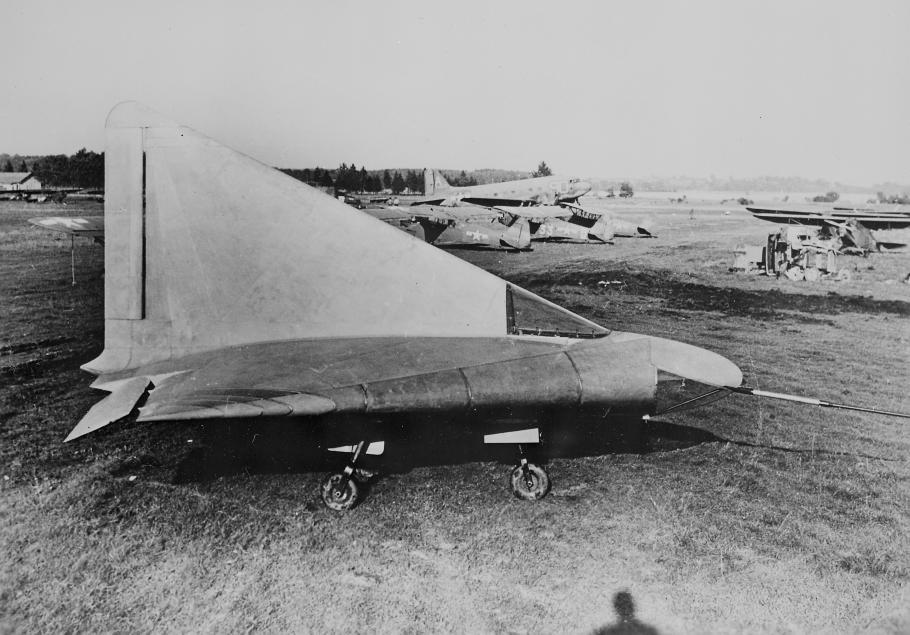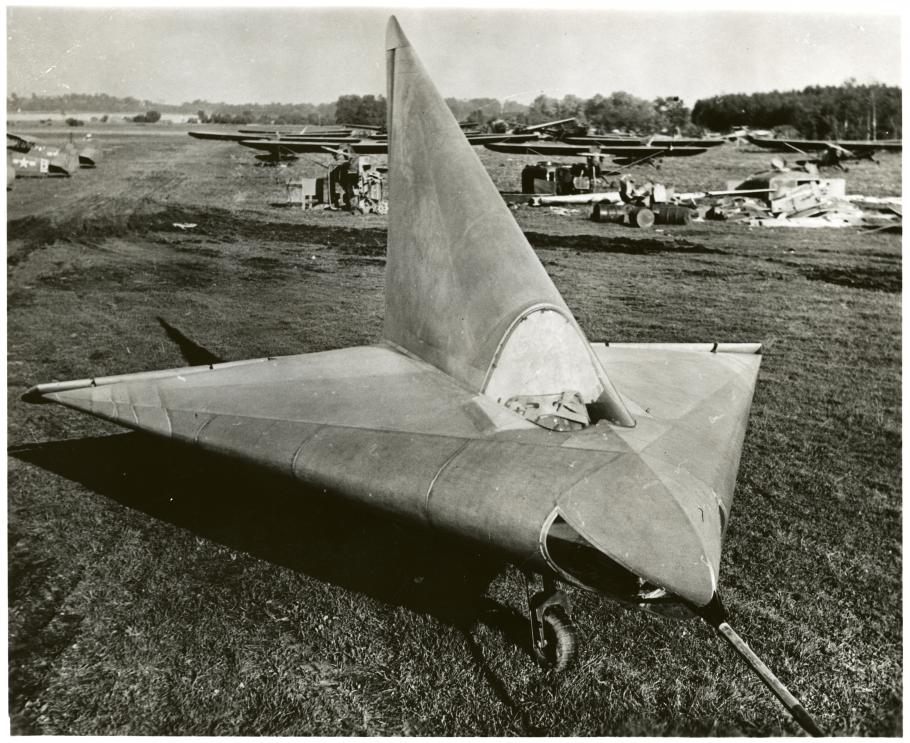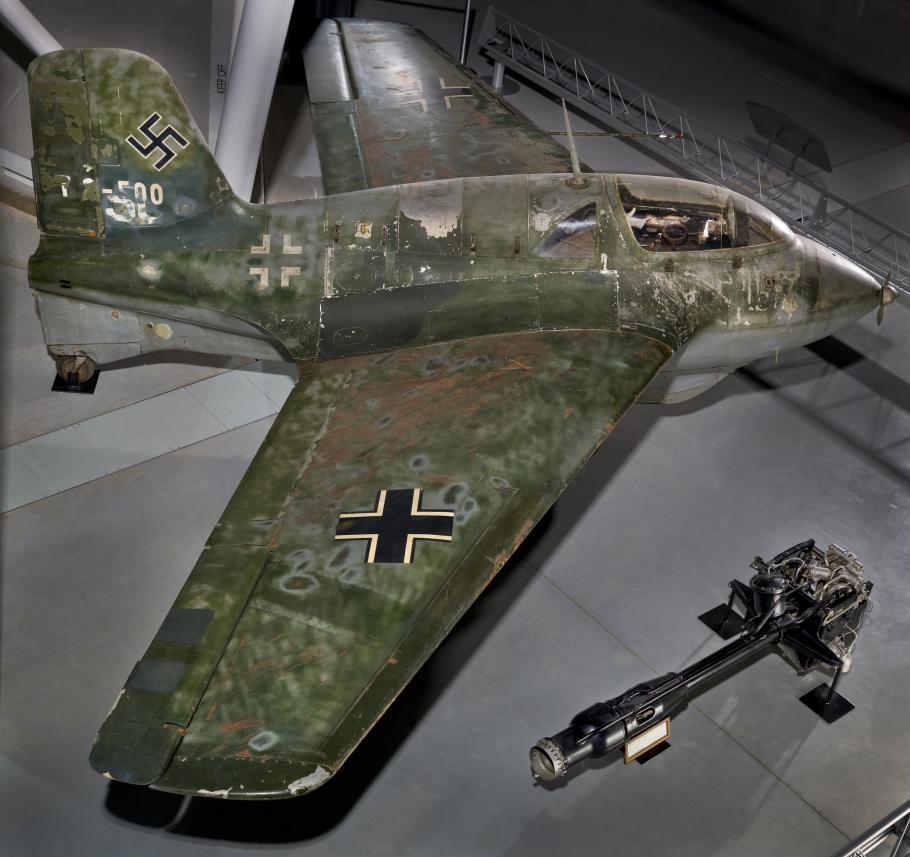In this four-part series, curators Russ Lee and Evelyn Crellin take an in-depth look at the Lippisch DM 1, an experimental German glider.
Lippisch DM-1
The Lippisch DM 1 played a vital role in the development of the first jet-propelled delta wing aircraft to fly, the Convair XF-92A. The extensive flight tests that Convair and the U. S. Air Force conducted with the XF-92A led the company to develop the Convair F-102 Delta Dagger and the F-106 Delta Dart, both delta wing fighters, as well as the B-58 Hustler supersonic delta wing bomber. The United States Air Force and the Air National Guard operated more than 1,400 of these aircraft from 1956 to 1988. For its role in the advancement of delta wing fighters, the Lippisch DM 1 warrants further examination from its early days in war-torn Germany to wind tunnels studies in the U.S.
The Lippisch DM 1, an experimental German glider, played a vital role in the development of the first jet-propelled delta wing aircraft to fly, the Convair XF-92A.
Alexander M. Lippisch, a German aircraft designer, devoted much of his career to understanding and developing advanced, unconventional aircraft. Between 1921 and 1945, he embarked on more than 100 projects that led to the construction and successful flight of about 60 different aircraft including the Messerschmitt Me 163 Komet rocket fighter, currently on display at the Steven F. Udvar Hazy Center in Chantilly, Virginia. The Komet was the world’s first operational fighter aircraft powered by a liquid-fueled rocket engine becoming operational in May 1944.
Messerschmitt Me 163 B-1a on display at the Steven F. Udvar-Hazy Center in Chantilly, Virginia. One of the most remarkable of the Wunderwaffen (wonder weapons) produced by the Nazi Germany during World War II, the Messerschmitt Me 163 Komet holds the distinction of being the first and only tailless rocket-powered interceptor to see operational service.
By the late 1930s, aircraft designers and engineers began to understand that traditional straight wings and relatively thick airfoils were not ideal for flight at the speed of sound or beyond. Sound travels at different speeds primarily due to variations in air temperature. At sea level and under normal atmospheric conditions it travels at 1,220 km/h (760 mph). To reduce the drag of the air that quadruples when airspeed doubles, and to solve other problems that arise at transonic speeds, Lippisch proposed a delta wing configuration so named because it resembles the fourth letter ‘Delta’ of the ancient Greek alphabet whose uppercase form looks like this: ‘Δ’. This shape has several advantages for high-speed flight. It combines sharply swept leading edges to minimize drag at high speeds with a large surface area needed to make lift at low speeds. The delta had favorable structural characteristics, too. It allowed engineers to build thin wings making less drag without losing the strength needed to withstand the powerful air loads encountered at transonic speeds.
In spring 1943, Lippisch took charge of the Luftfahrt-Forschungsanstalt Wien (Aeronautical Research Establishment Vienna, or LFW). He began working on several projects. One of them was the project “P 13 a,” the idea for a semi-tailless supersonic fighter aircraft. At the time, Allied bombing operations were increasing in scope and intensity. To counter the bombers, Germany needed new fighter aircraft with performance superior to Allied aircraft. The new designs also had to be quick to build using inexpensive materials that were easily obtained. To boost high-speed performance, Lippisch envisioned powering the P 13 a with a ram-jet engine that consisted of just a few moving parts and operated by burning a mixture of coal dust and heavy oil or gasoline.
The Reichsluftfahrtministerium, or German Air Ministry (RLM), became interested in this project, perhaps because several firms were already developing unusual forms of semi-tailless or all-wing designs for fighter aircraft powered by either jet turbine or rocket engines. In addition to the Me 163 B-1a already mentioned, another notable example is the all-wing Horten Ho 229 V3 (‘aich-oh two-two-nine vee-three’) currently on display in the Mary Baker Engen Restoration Hangar at the Steven F. Udvar-Hazy Center. Lippisch designed the P 13 a to be built of aluminum and he hoped it could attain supersonic speeds. The wing would be a cantilever structure, a smooth outer surface without external supports such as struts or wires. It would also have a 60° nose angle and a profile thickness of 15%—the thickness of the wing as a percentage of the width of the wing from leading to trailing edge.
Beginning in May 1944, experts evaluated the design at Spitzerberg Mountain near Vienna using a scale-model of the P 13 a. In August 1944, the aerodynamic characteristics of a P 13 a wind tunnel model were tested in the supersonic wind tunnel at Aerodynamische Versuchsanstalt, the Aerodynamic Research Institute (AVA) in Göttingen. Following these tests, Lippisch pushed to build a full-size version without an engine. A powered aircraft would tow aloft the experimental glider manned by a test pilot who would study the takeoff, landing, and handling qualities of the design in flight. A young man assisting Lippisch at the LFW was Wolfgang Heinemann, persuaded the designer that he and his fellow students of the Flugtechnische Fachgruppe (aeronautical expert groups, FFG) at Darmstadt Technical College could build the experimental glider according to Lippisch's specifications. Heinemann was one of many German students majoring in engineering and aeronautics who joined such academic flying groups where they obtained their pilots' licenses, tried to solve various aeronautical problems, and were not afraid to tackle challenges at the limits of the aeronautical sciences. The students began their work in August 1944. Since FFG Darmstadt numbered their designs sequentially, the new aircraft became the D 33. Lippisch later said the designation should have been “P 13 a V1” (Project 13 a, prototype 1).
Construction of the aircraft, however, was abruptly halted when Allied bombers struck Darmstadt, including the building that housed the FFG experimental glider project. Next week in Part 2, we will see what impact this had on the completion of the D 33.
Sources: Chambers, Joseph R. Cave of Winds: The Remarkable History of the Langley Full-Scale Wind Tunnel, (NASA SP-2014-614), 2014. Dabrowski, Hans-Peter, Überschalljäger Lippisch P 13 and Versuchsgleiter DM-1 (Supersonic Flighter P 13 abd Experimental Glider DM-1), Podzun-Pallas Verlag Stutgart 1986 Dabrowski, Hans-Peter. “Fliegendes Dreieck (Flying Triangle),” Klassiker der Luftfahrt, July 2014. Lippisch, Alexander M. The Delta Wing-History and Development, Gertrude Lippisch translator, (Ames, Iowa, 1981).


